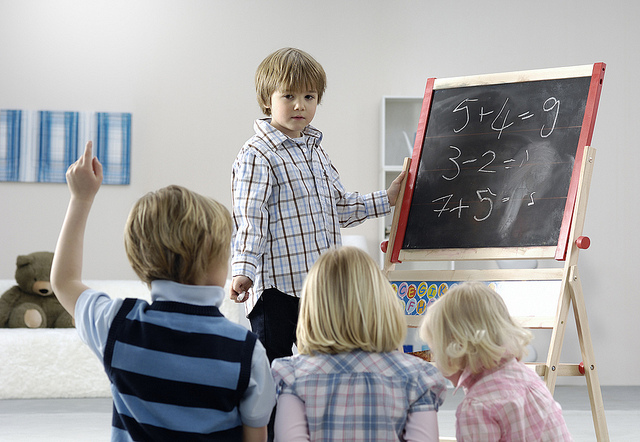Tech and Young Children: U.S. Dept. of Ed Elevates Need for Guidance and PD
Posted September 14, 2015 Flickr/
Flickr/ Now that digital technologies—and touch-screen tablets in particular—are finding their way into preschool and kindergarten classrooms, educators are faced with multiple questions about if, how, and when it is best to introduce them to young children. On September 3rd, the U.S. Department of Education brought together nearly 60 people from across the early childhood field to think through what would be of most help.
At least three needs became apparent throughout the day: Educators and parents need succinct, research-based messages about what works best. Teachers and leaders need professional development on how to skillfully integrate technology into their teaching. And the app marketplace needs markers of quality informed by the science of child development.
The roundtable strategy session, hosted by the Office of Early Learning and the Office of Educational Technology, drew in experts from across the country, including developmental scientists, family engagement specialists, education school faculty, public media leaders, and philanthropic foundations.
It opened with remarks from U.S. Secretary of Education Arne Duncan, who stressed the importance of helping young students who do not have the advantages of more well-off peers who are using technology to learn and create. “The stakes are high but the opportunities are amazing,” Duncan said.
Kwesi Rollins, director of leadership programs for the Institute for Educational Leadership, called on participants to consider technology in the context of the relationships between parents, educators, and community groups that are on the ground working with children everyday–particularly,” he said, “in communities that may need a little more help.”
The Joan Ganz Cooney Center and New America (Michael Levine and I) provided a brief presentation to show how the field has become more sophisticated about technology use over the past few years—but has much more work to do. [Slides here.]
For example, the technology position statement from The National Association for the Education of Young Children and the Fred Roger’s Center for Early Learning and Children’s Media is guiding an increasing number of PreK-3rd educators, and new Screen Sense guidelines from Zero to Three are making an impact on how professionals and parents work with and care for infants and toddlers. Both statements emphasize that if and when digital media is to be used, be sure that it promotes joint engagement between children and adults, and among children with each other, to stimulate conversation, language development, and on-and-off-line exploration. The American Academy of Pediatrics, which is known for its blanket statement of “no screens” before age 2, also puts its focus on the importance of social interaction.
[Much of this guidance is discussed in the forthcoming book by me and Levine, Tap, Click, Read: Growing Readers in a World of Screens, which describes what it will take to harness technology appropriately and improve the odds for literacy learning for the next generation, especially for children without access to mentors and resources. The field needs to become more intentional and forward-thinking in helping educators and communities create environments that enable new literacies. The tapclickread.org website, launched last week, provides more details.]
A new set of reports from the U.S. Department of Health and Human Resources is also available to help the field: Uses of Technology to Support Early Childhood Practice was published by the Administration for Children and Families last spring.
With these resources out there, several questions of the day centered on communication and outreach: Are educators and parents aware of these resources? Could the U.S. Department of Education play a role in dissemination and guidance? Could the guidance be boiled down into short, pithy statements that could take hold in classrooms, libraries, and households? Some groups, such as Abriendo Puertas, are trying to reach parents with one-page “tech tips” (here in English and here in Spanish). Common Sense Media, an advocacy organization and website that rates children’s media, has also provided bite-sized “screen time” guidance for parents. What might be the equivalent for educators, and how might they guide new professional learning opportunities?
And meanwhile, could the app stores be nudged into marking their products in a way that could steer parents and educators to better resources? For example, the Department of Ed has already published a guide for developers focused on the K-12 market.
Although the Obama Administration will be ending in less than 18 months, evidently it is not prepared to wind down yet. Libby Doggett, director of the Office of Early Learning, and Richard Culatta, director of the Office of Educational Technology, are actively seeking ideas and advice on how to make a difference on these issues in the coming year. The Sept 3 event sparked conversation on Twitter at #earlytech. Join in there if you have thoughts on how experts, stakeholder organizations, and federal agencies can help.
This post has also been published at EdCentral.org.












Thanks for this article; I am a few months late, but wanted to share a few thoughts. To: “I quickly discovered that there were an overwhelming number of educational apps…without downloading each app, and testing it out myself, it was difficult to tell which ones would be useful and which ones were a waste of learning time”– I’ll add, “and money.” and “amen”!
I read the Hirsh-Pasek, Zosh et al article. Thanks for the link. I absolutely agree that we must have some standard of measuring an app’s potential educational value; those metrics should be transparent, and they should be employed by developers and consumers alike.
This site’s Sept 14th blog post (http://www.tapclickread.org/tech-and-young-children-u-s-dept-of-ed-elevates-need-for-guidance-and-pd/ )
has a quote that is quite accurate and telling; and I believe is what Hirsh-Pasek/Zosh are aiming to rectify: “Educators and parents need succinct, research-based messages about what works best… the app marketplace needs markers of quality informed by the science of child development.”
As a teacher, one holding a Masters in the learning sciences, I recognize the validity of the research-based message of their four pillars. I think they have a good start. If this model were to be used to publish a review of an app, I would want to also see something like the bar graphs they include in their article showing how the four pillars combined to determine the rating on the left hand side of their grid.
I agree that “(t)heir proposal presents a solution to a problem that many parents and educators face” – however, regardless of which model/framework/standard we (hopefully) apply across the board, someone still has to actually use the app in order to determine if/how each of the four pillars are embedded in an app.
You provided a helpful link to a list of companies that review apps. Among those, my “first stop” is http://www.balefirelabs.org. They, too, hold fast to the science of learning. There is probably a great deal of overlap between the Hirsh-Pasek/Zosh framework and their rubric. The difference is, I don’t have to buy/download an app to do the measurement.
One last thought, stemming from a quote on the same Sep 14th post, re:: “Are educators and parents aware of these resources? Could the U.S. Department of Education play a role in dissemination and guidance?”
There ARE app review services available now, Balefire for example, there are more than enough resources for developers, policy makers, and consumers; these come from the DOE, the Office of EdTech, and many other stellar organizations. Why are “we” not reading/heeding the recommendations?
I think about this a lot. Just today a thought occurred to me when I was thinking about the potential of a government standard; something like a kind of “label” app stores/developers would be required to use: we have this same type of thing with nutritional value and truth in advertising. Yet, take a look at your local grocery store. I’ll wager there are more items in the snack isles than in the fresh food sections…and only an eye tracking device could capture how many people read nutrition labels on snack foods—and still buy them! (No judgment here. I’m from Texas…we nearly declared a state holiday when Blue Bell was back on the shelves!)
In the end, it is our responsibility to be proactive, educated, critical consumers for our children’s “educational nutrition”—and that means someone still has to assess the software, just as someone has to test the various food products in order to actually make the nutrition label. I think we are getting close…we are having these shared dialogues that will (hopefully) push the system.